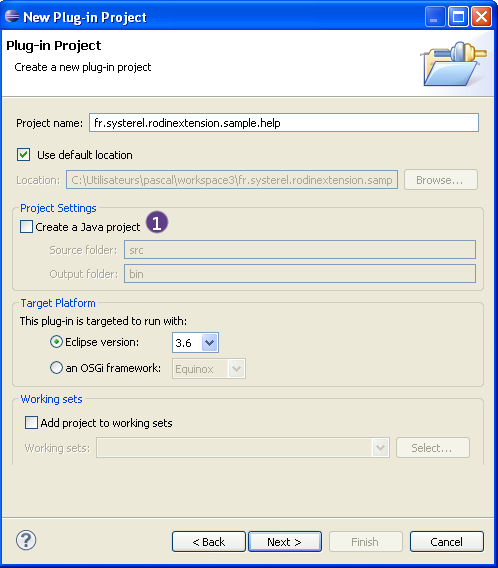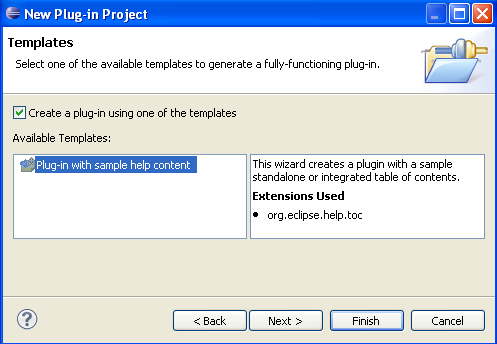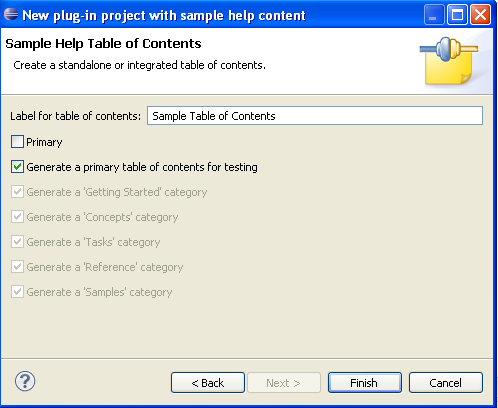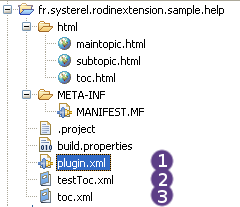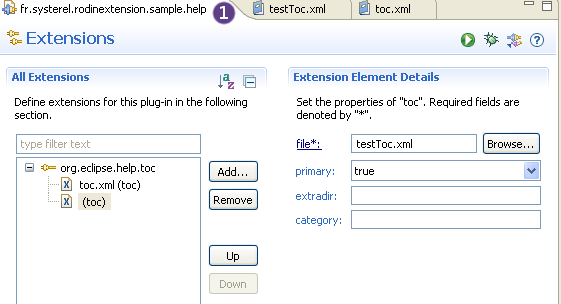Difference between pages "Proof Skeleton View" and "Providing help for your plug-in (How to extend Rodin Tutorial)"
From Event-B
(Difference between pages)
Jump to navigationJump to searchimported>Mathieu |
imported>Pascal |
||
| Line 1: | Line 1: | ||
| − | == | + | {{Navigation|Previous= [['''FIXME'''|Extending the Proof Obligation Generator]]|Next=[['''FIXME'''|Extending the structured editor]] | Up= [[Plug-in_Tutorial|How to extend Rodin Tutorial (Index)]]}} |
| − | + | === Providing Help Contents === | |
| + | Each plug-in that contributes help files shall extend the <tt>org.eclipse.help.toc</tt> extension point and create the TOC files that describe the table of contents for the help and the topic interleaving. | ||
| − | == | + | ==== Creating the Help Plug-in ==== |
| + | Let's first create such a plug-in. It will only contain documentation files, and the "Create Java Project" option (tag 1) do not need to be checked. | ||
| − | + | [[Image:help_project.png]] | |
| − | + | Then, the easiest way to proceed for beginners is to start from the available template: | |
| − | |||
| − | |||
| − | + | [[Image:help_project_template.png]] | |
| − | + | [[Image:help_project_toc.png]] | |
| − | + | ==== Examining the Help Files ==== | |
| + | [[Image:help_files.png | right]] | ||
| + | Three .xml files have been created: | ||
| + | # plugin.xml | ||
| + | # testToc.xml | ||
| + | # toc.xml | ||
| − | + | When opening the plugin.xml file, we can see that the testToc.xml file is a primary file, i.e. it contains the master table of contents; toc.xml is not primary, but is integrated into this table of contents. | |
| − | + | [[Image:help_plugin_file.png]] | |
| + | === Option 1: Writing the Help Files === | ||
| − | [[Category: | + | === Option 2: Generating the Help Files === |
| + | |||
| + | |||
| + | |||
| + | {{Navigation|Previous= [['''FIXME'''|Extending the Proof Obligation Generator]]|Next= [['''FIXME'''|Extending the structured editor]] | Up= [[Plug-in_Tutorial|How to extend Rodin Tutorial (Index)]]}} | ||
| + | |||
| + | [[Category:Developer documentation|*Index]] | ||
| + | [[Category:Rodin Platform|*Index]] | ||
| + | [[Category:Tutorial|*Index]] | ||
Revision as of 12:08, 23 August 2010
Contents
Providing Help Contents
Each plug-in that contributes help files shall extend the org.eclipse.help.toc extension point and create the TOC files that describe the table of contents for the help and the topic interleaving.
Creating the Help Plug-in
Let's first create such a plug-in. It will only contain documentation files, and the "Create Java Project" option (tag 1) do not need to be checked.
Then, the easiest way to proceed for beginners is to start from the available template:
Examining the Help Files
Three .xml files have been created:
- plugin.xml
- testToc.xml
- toc.xml
When opening the plugin.xml file, we can see that the testToc.xml file is a primary file, i.e. it contains the master table of contents; toc.xml is not primary, but is integrated into this table of contents.
